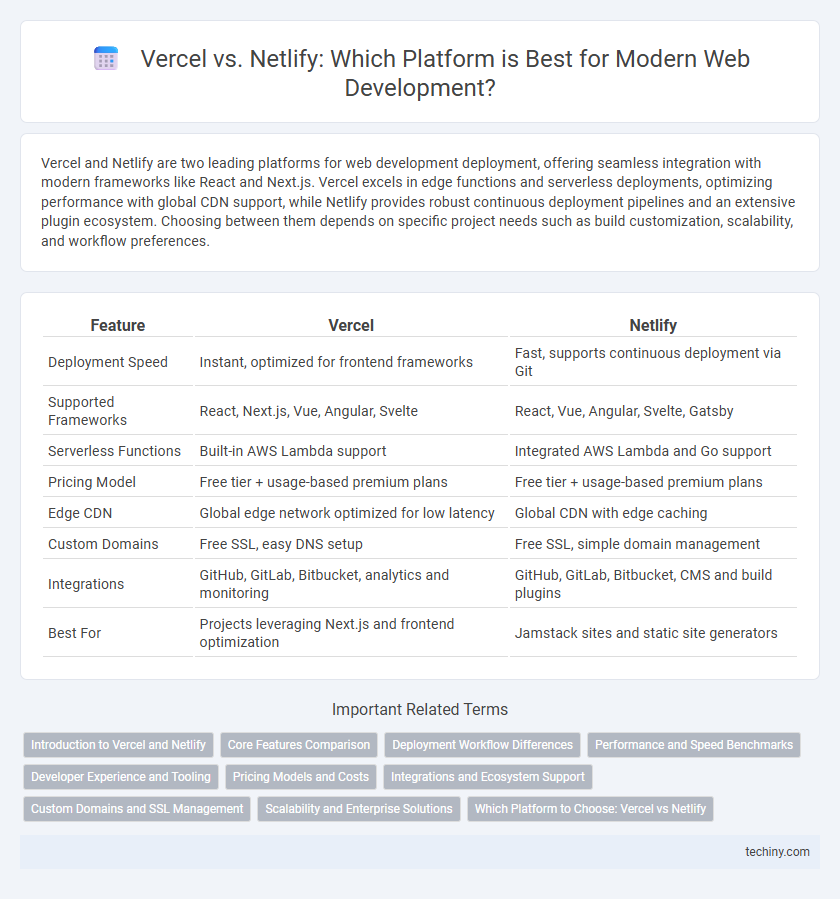Vercel and Netlify are two leading platforms for web development deployment, offering seamless integration with modern frameworks like React and Next.js. Vercel excels in edge functions and serverless deployments, optimizing performance with global CDN support, while Netlify provides robust continuous deployment pipelines and an extensive plugin ecosystem. Choosing between them depends on specific project needs such as build customization, scalability, and workflow preferences.
Table of Comparison
| Feature | Vercel | Netlify |
|---|---|---|
| Deployment Speed | Instant, optimized for frontend frameworks | Fast, supports continuous deployment via Git |
| Supported Frameworks | React, Next.js, Vue, Angular, Svelte | React, Vue, Angular, Svelte, Gatsby |
| Serverless Functions | Built-in AWS Lambda support | Integrated AWS Lambda and Go support |
| Pricing Model | Free tier + usage-based premium plans | Free tier + usage-based premium plans |
| Edge CDN | Global edge network optimized for low latency | Global CDN with edge caching |
| Custom Domains | Free SSL, easy DNS setup | Free SSL, simple domain management |
| Integrations | GitHub, GitLab, Bitbucket, analytics and monitoring | GitHub, GitLab, Bitbucket, CMS and build plugins |
| Best For | Projects leveraging Next.js and frontend optimization | Jamstack sites and static site generators |
Introduction to Vercel and Netlify
Vercel and Netlify are leading cloud platforms designed for modern web development, offering seamless deployment and scalable hosting solutions. Vercel specializes in optimized performance for frontend frameworks like Next.js, providing edge network capabilities and automatic CDN caching. Netlify excels with its integrated continuous deployment, serverless function support, and developer-friendly CLI, empowering rapid site builds and global distribution.
Core Features Comparison
Vercel offers seamless integration with frameworks like Next.js, automatic scaling, and edge functions for enhanced performance, while Netlify provides built-in continuous deployment, serverless functions, and form handling capabilities. Vercel's preview deployments allow real-time collaboration and instant feedback, whereas Netlify emphasizes a user-friendly interface with plugins and add-ons for extending functionality. Both platforms excel in global CDN distribution and developer experience, but Vercel leans towards performance optimization, and Netlify focuses on comprehensive site management features.
Deployment Workflow Differences
Vercel offers an integrated deployment workflow tightly coupled with Git, enabling automatic previews and seamless branch deployments for front-end frameworks like Next.js. Netlify provides a flexible deployment process supporting manual triggers, continuous integration from multiple Git providers, and customizable build settings for diverse static sites and JAMstack applications. The choice between the two depends on the need for streamlined previews with Vercel or configuration versatility with Netlify in deployment workflows.
Performance and Speed Benchmarks
Vercel and Netlify are leading platforms for web development deployment, with Vercel often outperforming in serverless function execution times and edge network distribution, resulting in faster global content delivery. Netlify excels in build speed optimizations and caching mechanisms, offering swift continuous deployment workflows that enhance developer productivity. Performance benchmarks highlight Vercel's superior Time to First Byte (TTFB) and Netlify's strength in build and deployment latency, making both platforms highly competitive based on specific project needs.
Developer Experience and Tooling
Vercel offers a seamless developer experience with instant deployments, automatic scaling, and integrated preview environments that streamline the workflow for frontend developers. Netlify provides robust tooling through its comprehensive build plugins and powerful continuous deployment pipelines, enhancing customization and automation. Both platforms excel in Git integration, but Vercel's optimized support for Next.js and serverless functions often gives it an edge in modern React application development.
Pricing Models and Costs
Vercel offers a free tier with basic features and charges based on usage for advanced functionalities, including team collaboration and increased bandwidth, with Pro plans starting at $20 per user per month. Netlify provides a free plan with essential capabilities and scales pricing based on build minutes, bandwidth, and team size, with its Pro plan priced at $19 per user per month. Both platforms include pay-as-you-go options for additional usage, but Netlify tends to be more cost-effective for smaller projects, while Vercel excels in performance optimization for enterprise-level deployments.
Integrations and Ecosystem Support
Vercel offers seamless integrations with popular front-end frameworks like Next.js, enabling optimized workflow and performance enhancements, while Netlify supports a broader range of JAMstack tools including Gatsby and Hugo, providing versatility for diverse project needs. Both platforms boast extensive plugin ecosystems, but Vercel emphasizes real-time collaboration tools and analytics, whereas Netlify focuses on build plugins and form handling integrations. Developers seeking a streamlined deployment experience with tight framework coupling may prefer Vercel, while those requiring flexible ecosystem support benefit from Netlify's expansive integration marketplace.
Custom Domains and SSL Management
Vercel and Netlify both offer seamless custom domain integration with automated SSL certificate provisioning via Let's Encrypt, ensuring secure HTTPS connections without manual configuration. Vercel simplifies domain management through its intuitive dashboard and instant SSL activation, ideal for developers seeking streamlined deployment workflows. Netlify also supports advanced DNS configurations and automatic SSL renewals, providing robust domain control paired with continuous security updates.
Scalability and Enterprise Solutions
Vercel offers robust scalability with a globally distributed edge network that automatically optimizes performance for high-traffic enterprise applications, ensuring seamless handling of concurrent users. Netlify provides scalable serverless functions and build pipelines designed for complex workflows, supporting enterprises with customizable integrations and strong CI/CD support. Both platforms emphasize scalability and enterprise-ready solutions but differ in their approach to edge computing and continuous deployment.
Which Platform to Choose: Vercel vs Netlify
Vercel excels in seamless integration with frameworks like Next.js and offers superior performance for dynamic serverless functions, making it ideal for developers prioritizing speed and edge computing. Netlify provides a robust continuous deployment pipeline, extensive plugin ecosystem, and built-in form handling, catering to projects requiring comprehensive build automation and CMS flexibility. Choosing between Vercel and Netlify depends on the project's specific needs: choose Vercel for optimized static site generation and real-time preview, or Netlify for extensive workflows and versatility in static site deployment.
Vercel vs Netlify Infographic

 techiny.com
techiny.com